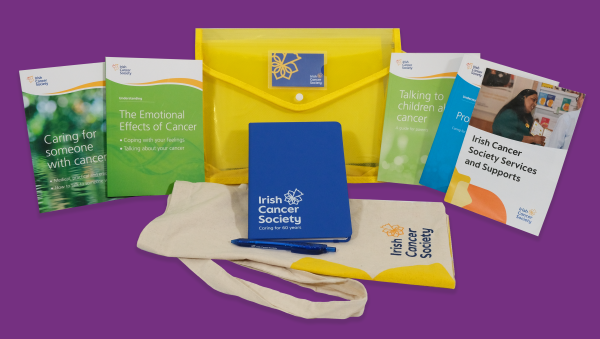Oesophageal cancer
Treatment
How is oesophageal cancer treated?
Your treatment plan will depend on:
- The type of oesophageal cancer you have
- The size of the tumour
- Where it’s found
- If it has spread to your lymph nodes or other parts of your body
- Your symptoms
- Your age and general health
Endoscopic treatments - EMR and ESD
For early-stage cancers, you may have treatment using an endoscope – this is a tube with a camera on the end that goes into your oesophagus through your mouth. Instruments – a knife or wire loop – are used to remove the cancer.
- Endoscopic mucosal resection (EMR) removes small cancers on the inner layer of the oesophagus.
- Endoscopic submucosal dissection (ESD) removes slightly bigger cancers that affect the layer below the mucosa, called the submucosa.
Radiofrequency ablation (RFA)
You may have another treatment called radiofrequency ablation (RFA) after EMR or ESD to reduce the risk of the cancer coming back. RFA uses heat energy (from radiowaves) to destroy cancer cells. The radiofrequency device is passed down the oesophagus (gullet) using an endoscope.
You will usually have a spray to numb your throat and you may have a sedative to make you feel relaxed and sleepy.
Surgery
If the cancer is found in only a small section of the oesophagus, it may be possible to remove the entire tumour along with the affected part of the oesophagus and lymph nodes. Often you will have chemotherapy or chemoradiation (chemotherapy and radiotherapy together) to reduce the size of the tumour before surgery.
Other treatments
Often you will have chemoradiation (chemotherapy and radiotherapy together) to reduce the size of the tumour before surgery. The chemotherapy drugs make the cancer cells more sensitive to radiation.
This uses high-energy rays to kill or shrink cancer cells. The rays are aimed directly at the tumour in your oesophagus. It can be given before surgery to shrink the tumour or after surgery to kill any cancer cells left behind to prevent the cancer coming back.
With advanced cancer, radiotherapy can also help to relieve symptoms like pain or difficulty swallowing.
Read more about radiotherapy.
Chemotherapy is the use of drugs to cure or control cancer.
Chemotherapy may be used alone or with radiotherapy. It can help to reduce the size of the tumour before surgery or to prevent it from coming back after surgery. It may be used to control the cancer if it has spread to other organs or if it recurs after surgery or adiotherapy. It may also be used to relieve symptoms.
There are several chemotherapy drugs used to treat oesophageal cancer. Chemotherapy drugs can be used on their own or in combination with each other. Your doctor or nurse will explain which drugs you’re having and what side-effects to expect.
Read more about chemotherapy.
Targeted therapy and immunotherapy drugs can stop cancer cells growing or spreading. They may be given if the cancer has spread to nearby tissues or other parts of the body. Immunotherapy may also
be given after your primary treatment to reduce the risk of the cancer coming back.
Targeted therapies
These drugs target certain parts of the cancer cells that make them different from other cells. For example, if your cancer cells have a lot of a protein called HER2, a targeted therapy drug called trastuzumab can attach to the HER2 proteins and stop the cancer cells from dividing and growing.
Some targeted therapies are given into a vein, as an infusion or an injection. Others may be given as tablets that you can take at home.
Side-effects of targeted therapies include flu-like symptoms, such as fever and chills, weakness, nausea, vomiting, cough diarrhoea and headache, an increased risk of infection and fatigue (tiredness).
Immunotherapy
Immunotherapy treatment is designed to boost
your own immune system to fight cancer. Cancer cells often disguise themselves in your body so that the immune system doesn’t recognise them as bad cells. Immunotherapy works by helping the
immune system to recognise and attack the bad cells caused by cancer. It can help to control the cancer and stop it from spreading.
Side-effects can occur at any time during or even after treatment is finished. Some side-effects are caused by the immune system - stimulated by immunotherapy - attacking healthy organs. This can
result in inflammation in different parts of the body. For example: colitis (inflammation of the bowel), causing diarrhoea and tummy pain; pneumonitis (inflammation of the lung), which can cause shortness of breath or a cough; inflamed skin, causing rash or
dryness.
Occasionally, radiotherapy is given by putting a radioactive source inside your body for a few minutes. This can help to slow down the growth of cancer cells. Different doses can be given but often a high dose rate is given for a very short time.
Treatment
Your doctor will first spray the back of your throat with local anaesthetic. A fine tube is then placed in your oesophagus through your nose. Then your doctor will take an X-ray to help them plan the treatment.
Once the planning has been done, the radioactive source will be put into the tube. It will travel to the area to be treated, gives the treatment and then returns safely to the machine. The planning X-ray lasts about 1 hour and the treatment itself takes about 10 minutes.
Once the tube is removed, you can go home. No radioactivity will be left in your body so it is safe for you to mix with family and friends. Usually, only 1 or 2 treatments are needed.
Side-effects of brachytherapy
- The treatment may cause nausea and soreness when swallowing. These may happen a few days after treatment and last for a few days. Your doctor can prescribe medication to help with swallowing and ease any nausea and soreness. You will not have any hair loss with this treatment.
- If you feel unwell or have any other side-effects or symptom – during or at any time after treatment – tell your doctor, nurse or radiation therapist.
Treatments for swallowing problems
Difficulty swallowing can be caused by the tumour itself or if the oesophagus is narrowed after surgery or radiotherapy.
If you have difficulty swallowing, with food becoming stuck in the oesophagus, tell your medical team as soon as possible.
Several treatments are available to help you to maintain your nutrition if you have swallowing difficulties. This can include temporary dilatation, the use of a feeding tube, oesophageal stent, or radiation treatment.
If you find fluids are going down the wrong way, you may also need to see a speech and language therapist who can assess your swallow and recommend safe foods and fluids for you to eat and drink. Sometimes, people may need to use a thickener, which they can add to their fluids to make them safer to swallow.
The dietitian at the hospital can give you advice on eating. They can advise you on ways to make foods easier to swallow and ways to get the most nutrition possible into your diet.
Oesophageal dilatation is a treatment that stretches and widens a narrowed area in your oesophagus so food and drink can pass through again. It uses an instrument called a dilator and it can be done quickly under general or local anaesthetic.
The dilatation may last only a short time and may need to be repeated a few weeks or months later. A different type of dilator might be used instead. Your doctor and dietitian can advise you on the best consistency of food to take after the dilatation.
A hollow tube called a stent is put into your oesophagus. The stent is usually made of plastic or flexible wire mesh. It is put in under local or general
anaesthetic like during an endoscopy. Once in place, it expands to keep your oesophagus open so you can swallow more easily.
After treatment you can usually start taking fluids. Gradually you will be given small amounts of soft food to eat. Your dietitian will advise you on the type of foods you should eat. You will need to chew your food thoroughly before swallowing so the stent does not get blocked. Foods that are soft and moist are generally the most suitable. It is often best to avoid bread or large pieces of meat. But you may need to blend your food too. Having drinks with your food and after food can help to keep the stent clean.
Always tell your medical team if you have difficulty swallowing.
Will I get side-effects?
The type of side-effects you get will depend on the type of treatment, the dose, the duration and your own general health. Your doctor or nurse will discuss any possible side-effects with you before your treatment.
Eating and swallowing difficulties are common with oesophageal cancer.
Read more about coping with cancer side-effects and symptoms.
Treating oesophageal cancer that has spread (metastatic cancer)
If the cancer spreads to another part of your body, it is called
metastatic, secondary or stage IV (4) cancer.
Your cancer may be in more than one part of your body when it is first diagnosed.
If your cancer has spread it can still be treated. Treatment is usually to try to control the cancer rather than to cure it. There is a range of treatment options for more advanced cancers and new treatments are being developed all the time. Often metastatic cancer is treated with chemotherapy, targeted therapies or immunotherapy. There may also be treatments that you can have as part of a clinical trial.
You can also have treatment to help with any symptoms. You may be referred to the palliative care team, who are experts in managing the symptoms of metastatic cancer.
Thanks to recent advances in research and treatments, many people are living longer with metastatic cancer and with a better quality of life.
Continue reading about oesophageal cancer




Get help & support

Support Line
Free support pack

